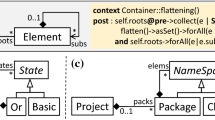Abstract
A model-based engineering discipline presupposes that models are organised by creating relationships between them. While there has been considerable work on understanding what it means to instantiate one model from another, little is known about when a model should be considered to be a specialisation of another one. This article motivates and discusses ways of defining specialisation relationships between models, languages, and transformations respectively. Consideration is given to both structural and behavioural compatibility concerns. Several alternatives of defining a specialisation relationship are considered and discussed. The article furthermore discusses the notions of referee and context in order to validate and define specialisation relationships. The ideas and discussions presented in this article are meant to provide a further stepping stone towards a systematic basis for organising models.
Similar content being viewed by others
References
Abadi M., Cardelli L.: On subtyping and matching. In: Olthoff, W. (ed) Proceedings ECOOP ’95. LNCS, vol. 952, pp. 145–167. Springer, Aarhus, Denmark (1995)
Arnold K., Gosling J., Holmes D.: The Java programming language, 3rd edn. Addison-Wesley, Reading (2000)
Atkinson C., Kühne T.: Rearchitecting the UML infrastructure. ACM Trans. Model. Comput. Simul. 12(4), 290–321 (2003)
Atkinson C., Kühne T.: A tour of language customization concepts. In: Zelkowitz, M. (ed) Advances in Computers, vol 70, Chap 3, pp. 105–161. Academic Press, Elsevier, Amsterdam (2007)
Bézivin, J., Büttner, F., Gogolla, M., Jouault, F., Kurtev, I., Lindow, A.: Model transformations? Transformation models! In: Proceedings of the 9th International Conference, MoDELS 2006, Genova, Italy. Lecture Notes in Computer Science, Vol. 4199, pp. 440–453. Springer Verlag, Berlin (2006)
Bézivin J.: In search of a basic principle for model driven engineering. Special Novática Issue “UML and Model Engineering” 2, 21–24 (2004)
Brachman R.: What is-a is and isn’t: an analysis of taxonomic links in semantic networks. Computer 16(10), 30–36 (1983)
Carnap R.: Meaning and Necessity: A Study in Semantics and Modal Logic. University of Chicago Press, USA (1947)
Cook, S., Kleppe, A., Mitchell, R., Rumpe, B., Warmer, J., Wills, A.: Defining UML family members using prefaces. In: Mingins, C., Meyer, B. (eds.) Proceedings of Technology of Object-Oriented Languages and Systems, TOOLS’99 Pacific. IEEE Computer Society (1999)
Cook, W.: A Denotational Semantics of Inheritance. Ph.D. thesis, Brown University (1989)
Cook, W.R., Hill, W., Canning, P.S.: Inheritance is not subtyping. In: Proceedings of the 17th ACM SIGPLAN-SIGACT symposium on Principles of programming languages, pp. 125–135. POPL ’90, ACM, New York, NY, USA (1990). http://doi.acm.org/10.1145/96709.96721
Engels, G., Hausmann, J., Heckel, R., Sauer, S.: Testing the consistency of dynamic UML diagrams. In: Proc. Int’l Conf. Integrated Design and Process Technology (IDPT) (2002)
Engels, G., Küster, J.M., Heckel, R., Groenewegen, L.: Towards consistency-preserving model evolution. In: IWPSE ’02: Proceedings of the International Workshop on Principles of Software Evolution, pp. 129–132. ACM, New York, NY, USA (2002)
Erné M, Koslowski J, Melton A, Strecker GE.: A primer on Galois connections. In: Summer Conference on General Topology and Applications, Vol. 704, pp. 103–125 (1991)
Ernst, E.: gbeta—A Language with Virtual Attributes, Block Structure, and Propagating, Dynamic Inheritance. Ph.D. thesis, Devise, Department of Computer Science, University of Aarhus, Aarhus, Denmark (Jun 1999)
Ernst E.: Family polymorphism. In: Knudsen, J.L. (ed) Proceedings of ECOOP 2001LNCS, vol. 2072, pp. 303–326. Springer-Verlag, Heidelberg, Germany (2001)
Favre, J.M.: Foundations of meta-pyramids: Languages vs. metamodels - episode ii: Story of thotus the baboon. In: Language Engineering for Model-Driven Software Development, Dagstuhl Seminar Proceedings 04101. Internationales Begegnungs- und Forschungszentrum für Informatik (IBFI), Schloss Dagstuhl (2004)
Harel, D., Rumpe, B.: Modeling languages: Syntax, semantics and all that stuff—part I: The basic stuff. Tech. Rep. MCS00-16, Faculty of Mathematics and Computer Science, The Weizmann Institute of Science, Israel (2000)
Håvaldsrud, T.V., Møller-Pedersen, B.: Nested and specialized associations. In: RAOOL ’09: Proceedings of the Workshop on Relationships and Associations in Object-Oriented Languages, pp. 25–31. ACM, New York, NY, USA (2009)
Kühne T.: Matters of (meta-) modeling. Softw. Syst. Model. 5(4), 369–385 (2006)
LaLonde W., Pugh J.: Subclassing ≠ Subtyping ≠ Is-a. J. Object-Oriented Program. 3(5), 57–62 (1991)
Liskov B.H., Wing J.M.: A behavioral notion of subtyping. ACM Trans. Program. Lang. Syst. 16(6), 1811–1841 (1994)
Meyer, B.: EIFFEL the language. Object-Oriented Series. Prentice Hall (1992). http://www.amazon.com/Eiffel-Language-Prentice-Object-Oriented-Series/dp/0132479257
Morgan C.: On the Refinement Calculus. Springer-Verlag, Berlin (1994)
Murer, S., Omohundro, S., Szyperski, C.: Engineering a programming language: The type and class system of Sather. In: Gutknecht, J. (ed.) Programming Languages and System Architectures, pp. 208–227. Springer Verlag, Lecture Notes in Computer Science, vol. 782 (1993)
Reeves, S., David, S.: A unified theory of testing. In: Hosking, J. (ed.) Proc Software Innovation and Engineering New Zealand Workshop 2007 (SIENZ’07) (2007)
Reeves S., Streader D.: General refinement, part one: interfaces, determinism and special refinement. Electron. Notes Theor. Comput. Sci. 214, 277–307 (2008)
Reeves S., Streader D.: General refinement, part two: flexible refinement. Electron. Notes Theor. Comput. Sci. 214, 309–329 (2008)
Steel J., Jézéquel J.M.: On model typing. Softw. Syst. Model. 6(4), 401–413 (2007)
Wang, X.H., Gu, T., Zhang, D.Q., Pung, H.K.: Ontology based context modeling and reasoning using owl. In: IEEE International Conference on Pervasive Computing and Communication (PerCom’04), pp. 18–22 (2004)
Wirth N.: Program development by stepwise refinement. Commun. ACM 14, 221–227 (1971)
Author information
Authors and Affiliations
Corresponding author
Additional information
Communicated by Prof. Dorina Petriu.
Rights and permissions
About this article
Cite this article
Kühne, T. On model compatibility with referees and contexts. Softw Syst Model 12, 475–488 (2013). https://doi.org/10.1007/s10270-012-0241-4
Received:
Revised:
Accepted:
Published:
Issue Date:
DOI: https://doi.org/10.1007/s10270-012-0241-4




